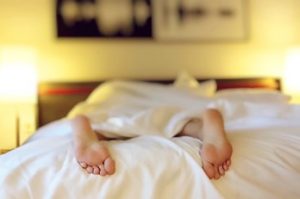 How often do you wake up with a wet spot on your pillow? Everyone drools occasionally, like when battling a stuffy nose. If the issue is ongoing, it could be a symptom of an underlying condition, like sleep apnea. Although the two may not seem related, hypersalivation can be a sign of breathing disruptions while you’re sleeping. Obstructive sleep apnea and drooling go hand in hand, and here’s why.
How often do you wake up with a wet spot on your pillow? Everyone drools occasionally, like when battling a stuffy nose. If the issue is ongoing, it could be a symptom of an underlying condition, like sleep apnea. Although the two may not seem related, hypersalivation can be a sign of breathing disruptions while you’re sleeping. Obstructive sleep apnea and drooling go hand in hand, and here’s why.
What is Obstructive Sleep Apnea?
Obstructive sleep apnea is a disorder that causes frequent pauses in breathing while sleeping. The soft tissues in the back of the mouth collapse to block the airway, depleting your body of oxygen and interrupting your sleep cycle.
Since the breathing disruptions occur while you’re sleeping, they can be difficult to detect, but there are other signs of the disorder, including:
- Loud, chronic snoring
- Waking out of breath, choking, or gasping
- Morning headaches
- Daytime fatigue
- Difficulty learning
- Memory loss
- Mood changes or irritability
- Sore or dry mouth upon waking
Drooling and Obstructive Sleep Apnea
Drooling occurs when excess saliva comes out of your mouth. Your swallowing reflexes relax while you’re sleeping, which allows saliva to accumulate and escape through the sides of your mouth.
Drooling is common when breathing through the mouth. As a result, it can be a risk factor for sleep apnea because mouth breathing is a regular occurrence.
Treating Obstructive Sleep Apnea
Treating sleep apnea can reduce drooling and boost your overall wellness. A CPAP is the most traditional method of treating the disorder. A machine delivers a stream of air pressure through a mask worn over the mouth or nose. Although it’s effective, it can be bothersome for some patients.
An oral appliance is a great alternative to a CPAP. The custom-fit device repositions the tongue and jaw to keep the airway open to prevent pauses in breathing. It’s proven to improve symptoms of mild-to-moderate obstructive sleep apnea when used consistently.
Reduce Your Risk of Drooling
If drooling is still an issue after beginning sleep apnea therapy, there are a few solutions to try at home, like:
- Sleep Position: Try sleeping on your back, which allows you to better control the flow of saliva.
- Nasal Congestion: Treat allergies or nasal congestion to prevent mouth breathing.
- BOTOX: Injecting BOTOX into the salivary glands can reduce saliva overproduction.
With the right sleep apnea treatment and a few changes to your bedtime routine, drooling will be the last thing on your mind. You will breathe easier to improve your sleep quality and overall wellness.
About Dr. West
Dr. West earned her dental degree at the University of Southern California Dental School and has continued her education to focus on many specialties, like sleep apnea therapy, neuromuscular dentistry, and full mouth reconstruction. She is a proud member of the American Academy of Sleep Medicine and many other professional organizations. If you’re interested in an oral appliance for snoring or sleep apnea, request an appointment through our website or call (702) 602-4000.
